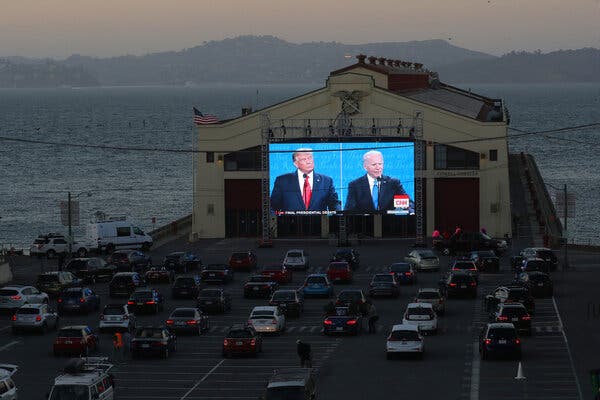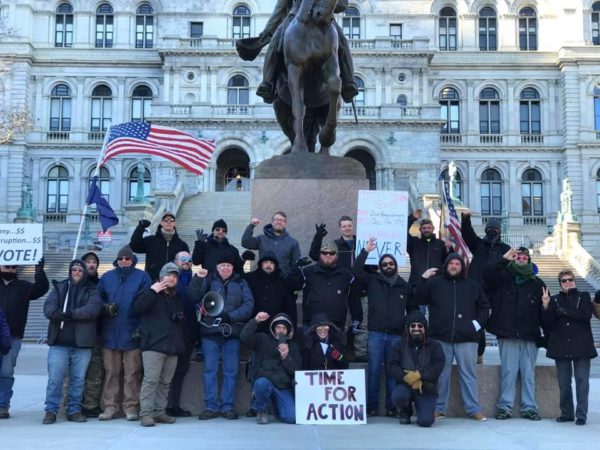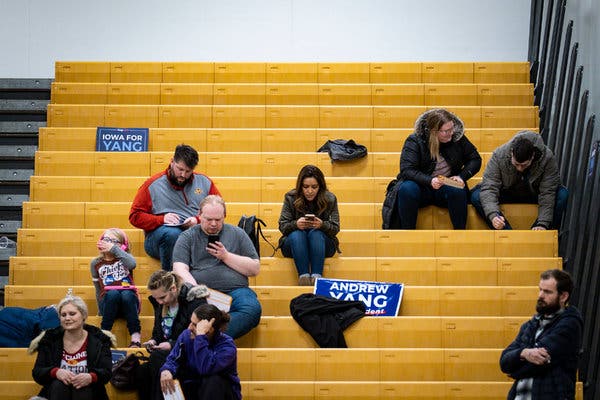Advertisement
At the debate, President Trump and Joe Biden were actually able to debate. Offstage, both candidates are carrying on distinctly different campaign styles that suit them best.

Welcome to our weekly analysis of the state of the 2020 campaign.
-
Joe Biden’s lead in national polling averages, including The Upshot’s, tapered ever so slightly this week — dipping just barely below 10 percentage points but seeming to hold steady there.
-
In national surveys released by both The New York Times/Siena College and Quinnipiac University, Mr. Biden led President Trump by double digits among the oldest voters as well as the youngest, a stark example of how he has scrambled the standard political calculus.
-
A Times/Siena poll of Montana released on Friday showed Mr. Trump maintaining a six-point lead there, and Senator Steve Daines, a pro-Trump Republican, appearing to hold off his Democratic challenger, Gov. Steve Bullock. Mr. Daines led by three points in the closely watched race, a difference that is within the poll’s margin of error.
-
The Biden campaign reported far more money in the bank than the Trump campaign as of mid-October: $162 million to $43.6 million. The disparity was $335 million to $223 million when all party funds are included.

President Trump did what his advisers wanted him to do at the debate on Thursday night, despite his lack of prep sessions: He didn’t interrupt former Vice President Joseph R. Biden Jr., and he toned himself down. But with less than two weeks left in the race, and nearly 50 million votes already cast in the election, the time for a reset that changes the dynamics of a race whose dynamics have not changed much since March is dwindling. The bulk of the conversation on the debate stage was still about the president’s handling of the coronavirus, where he offered little new.
He accepted responsibility for the 220,000 lives lost, while deflecting any blame, all in the same breath. “I take full responsibility, but China brought it here,” he said. “It’s not my fault.” He asserted that “2.2 million people modeled out were expected to die,” a claim he often repeats but for which there is no clear backing. Mr. Trump’s attempts to paint Mr. Biden as both corrupt and a Trojan Horse of the left fell flat (“he thinks he’s running against someone else,” Mr. Biden pushed back at one point). And the issue of law and order that the president wanted to elevate has dwindled in most parts of the country since a summer of protests.
Nearing the end of the race, Mr. Trump has not succeeded in making the election anything but a referendum on himself: his coronavirus response, his tone and his tweets.
In North Carolina this week, Mr. Trump appeared in Gaston County, a reliably Republican county outside of Charlotte that hasn’t had a visit from a general election candidate since President George H.W. Bush stopped there in 1992. In Florida, he visited The Villages, the nation’s largest retirement community that used to be part of his core constituency of older voters. In Wisconsin next week, Mr. Trump is set to visit Waukesha, a county he won four years ago by his biggest margin in the state.
-
He’s working hard to hold onto what he has His rally schedule indicates that his campaign has essentially given up on the suburbs in some battleground states where he has been bleeding support. “Everything we’ve seen from Trump politically, he always goes back to his base,” said Doug Heye, a former communications director for the Republican National Committee.
-
Trump believes in his own magic The president is disregarding all Covid-19 guidelines and hosting large gatherings in states where the number of positive cases is rising. It is somewhat of a repeat of his endgame strategy in 2016, when his advisers told him he was not likely to win but he held rallies until the end of the race. He has since credited himself with pulling himself over the finish line. The difference this time is that there has yet to be any outside event — like James B. Comey, the former F.B.I. director, announcing new evidence related to the Hillary Clinton email investigation — to fundamentally alter the race.
-
His advisers think the ground game could still pull them through While Democrats have relied more on digital advertising, the Trump campaign has been door-knocking aggressively. Campaign aides described the final weeks of the campaign as “white-knuckling it” until the end, and said that if a victory on Nov. 3 came through, it would be because of organizers targeting voters aggressively in the battleground states, more than anything Mr. Trump himself says onstage.
It is a misnomer to think of Nov. 3 as Election Day. Millions of Americans have already voted, using methods like early voting or casting an absentee ballot by mail. In fact, amid the continued spread of coronavirus, most experts believe this presidential election will feature more Americans voting outside of the in-person ballot box than ever before.
That reality has led to some eye-catching early vote totals in several states. However, projecting early vote counts onto Election Day results has been a pitfall of election analysis for years. Here are some things we know — and don’t know — based on the number of ballots that have already been cast.
-
Voter enthusiasm There is evidence that this presidential cycle will see increased turnout from four years ago. Several states have already broken early voting turnout records, including Georgia and North Carolina. In Texas, the populous Harris County is about to surpass its entire 2016 vote total in early voting alone — more than 1.3 million people. This comes as increased turnout has been a feature of elections in Mr. Trump’s presidency, from the midterms to down-ballot races. It speaks to a reality that has been true for Mr. Trump for years — he inspires fervent passion among his base but also significant backlash.
-
Beware of projecting Democrats are projected to have cast more ballots in the early voting process. This does not mean a Democratic victory is assured by Election Day, however, because both parties expect Mr. Trump’s backers to favor in-person ballot casting on Nov. 3. This is for several reasons, including that Democrats tend to live in more urban areas and have longer wait times. It is also because Mr. Trump and Republicans have railed against mail voting.
-
The system is holding Election observers’ worst fear was a voting system that could not handle the surge of activity and would fail. So far, the system has held up. In Georgia, initiatives such as converting a basketball arena into a socially distanced voting station have been a success. Election Day will provide the largest stress test of all, but the run-up has sent encouraging signs to election integrity officials.
Mr. Biden’s campaign has a clear path to victory by flipping Wisconsin, Pennsylvania, Florida and Michigan. However, the campaign is increasingly hearing pleas from Democrats in states that were once considered a long shot, such as Georgia, Texas, Iowa and Ohio.
Mr. Biden’s campaign, however, has long maintained that the race is closer than it appears in polling, and that it needed to conserve resources for must-win states. In recent days, though, some signs have pointed to a late-game push by Democrats into states that are considered surplus. In part, they are following the advice of some prominent Democrats and big donor groups, who have pleaded with Mr. Biden’s campaign that a big win is necessary to kick off a transformative presidency. Here’s what to know about the Biden campaign’s strategy in deep red states.
-
Don’t expect Biden himself Mr. Biden’s campaign has sent several surrogates to Georgia, Iowa, Ohio and Texas — including his running mate, Senator Kamala Harris of California. The campaign wants those surplus states to feel engaged and supported. However, the campaign will remember how the Clinton campaign was mocked for caring more about harder-to-win states while neglecting the core battlegrounds.
-
They have the money Mr. Biden is raising eye-popping sums, entering the campaign’s final month with more than a quarter of a billion dollars on hand. The campaign can afford to keep up television advertisements in Georgia while mounting a blitz in Pennsylvania.
-
Senate control is in the balance States like Georgia, Texas and Iowa may not be necessary for Mr. Biden to win the White House, but they are crucial to answering whether Democrats will be able to retake the Senate. Mr. Biden will be well aware of that importance, as much of former President Barack Obama’s agenda throughout his tenure was stymied by a Republican Senate that fought him at every turn. Senate races in Georgia, Texas and Iowa are polling at near statistical ties. As Mr. Biden keeps a presence in these states, it is also to help those down-ballot Democrats get over the line.
-
College students can register to vote either at their campuses or in their hometowns, which leaves students with a strategic choice: Their votes might be more likely to make a difference in a battleground state or in a swing district.
-
Disinformation is even more rampant this election cycle than it was in 2016. Colorado has set up a new initiative that will run ads on social media and expand digital outreach to help voters identify foreign misinformation. Very few states are following suit.
Shane Goldmacher, Isabella Grullón Paz and Giovanni Russonello contributed reporting.




